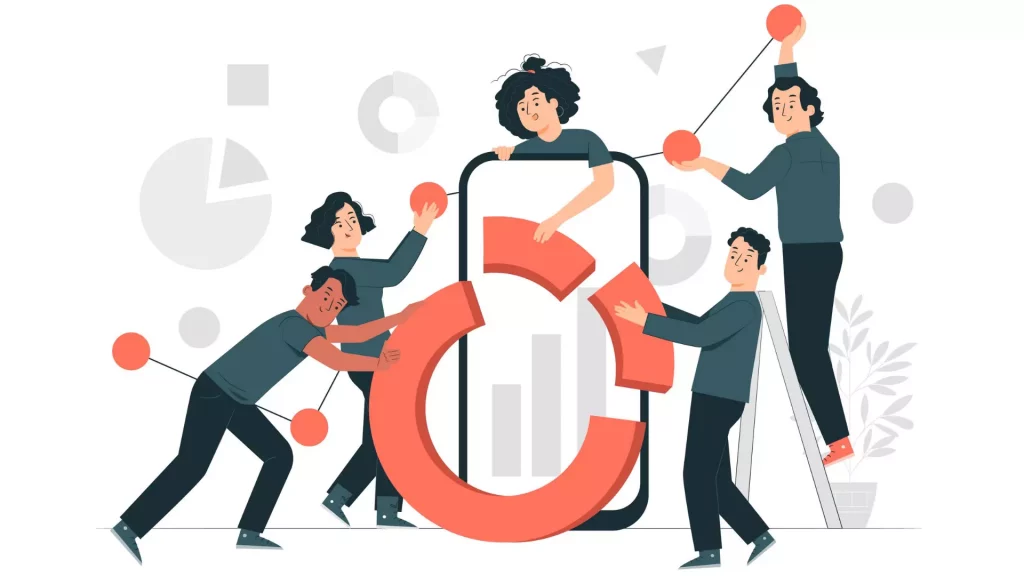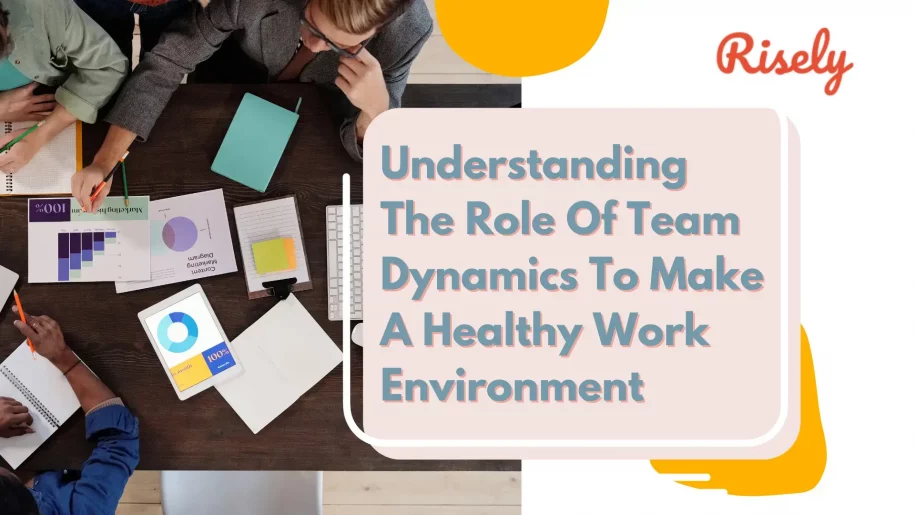Understanding The Role Of Team Dynamics To Make A Healthy Work Environment
Getting the team dynamics right is tricky, but it is incredibly beneficial when you land on the right path. Team dynamics is essential to understand and implement to promote collaboration and drive your team towards the set goal. In this blog, we have covered all the details you need to know about team dynamics to how you can implement it to get better results; also, for a bonus, we have added 3 real-life examples of effective team dynamics. So let’s dive in and get the dynamics right!What is team dynamics, and why is effective team dynamics important?
Team dynamics is how team members interact with each other and can significantly impact communication, collaboration, and productivity. This involves understanding individual strengths and weaknesses, communication patterns, decision-making processes, and conflict-resolution skills. Positive team dynamics can foster a healthy work environment, improving productivity and collaboration among team members. Conversely, negative team dynamics can lead to dysfunction and decreased performance. Therefore, team leaders must understand the concept of team dynamics and actively work towards creating a positive and productive team culture. Effective team dynamics are crucial for the success of any business. When team members work together effectively, communication and collaboration are improved, leading to increased productivity and a more efficient work environment. Positive team dynamics promote job satisfaction, creativity, and innovation as individuals feel valued and supported. Furthermore, a healthy team dynamic can mitigate conflicts and resolve issues quickly, leading to a more harmonious work environment. Thus, creating a dynamic team is essential for any organization looking to succeed in today’s competitive market.Benefits of positive team dynamics
Positive team dynamics can have a significant impact on a workplace; here are some benefits of it;Increased productivity
When team members trust and support each other, they are more likely to collaborate and accomplish tasks efficiently. This is because positive team dynamics encourage open communication, constructive feedback, and mutual respect and trust among team members. When people feel valued and respected by their colleagues, they are more likely to be engaged and motivated. A healthy work environment created by positive team dynamics can improve job satisfaction and employee retention.Better decision-making
When individuals feel comfortable expressing their opinions and ideas, it leads to more diverse and creative solutions. This results in better outcomes and promotes a sense of collaboration and teamwork. Effective communication within a team also helps ensure that everyone is on the same page and clearly understands the task at hand. A team with positive dynamics allows for constructive feedback without fear of judgment, resulting in a healthier work environment where everyone feels valued and supported.Enhanced creativity and innovation
Positive team dynamic have a significant impact on enhancing creativity and innovation in the workplace. When team members feel comfortable sharing their ideas and opinions, they are more likely to develop new and inventive solutions. This culture promotes creativity and encourages team members to take risks and approach problems from different perspectives, leading to more innovative outcomes. Check out: 6-step template to make Reverse Brainstorming the Key to Unlocking InnovationOther Interesting Reads
Negative impacts of poor team dynamics
Having a positive team dynamic is crucial for any organization. On the other hand, a team with poor dynamics can have numerous negative impacts on the organization, such as;Decreased productivity
When team members don’t communicate effectively or work well together, it can result in missed deadlines, unfinished projects, and low-quality work. Negative attitudes and conflicts between team members also contribute to decreased productivity.Negative impact on employee morale
When there is tension, conflict, and lack of communication among team members, it can lead to dissatisfaction and demotivation. In addition, the toxic work environment created by poor team dynamics can result in absenteeism, higher turnover rates, and decreased productivity. To address this issue, leadership must prioritize building strong relationships among team members and addressing conflicts as soon as they arise. Encouraging collaboration, providing opportunities for professional development, and fostering open communication are all effective ways to improve team dynamics and boost employee morale.Higher turnover rates
When employees feel disconnected, disengaged, and unsupported by their colleagues or leadership, they may seek alternative job opportunities that better fit their needs. High staff turnover rates can be costly for businesses in terms of recruitment expenses, training costs, and lost productivity. A toxic work environment can also harm the organization’s reputation, making attracting and retaining top talent more challenging. Therefore, investing in building positive team dynamics to reduce staff turnover rates and create a healthy work culture is crucial. Save your team by avoiding these mistakes: What is a toxic manager and how to never become one?How do leaders improve team dynamics in your workplace?
Improving team dynamic in your workplace is critical for creating a positive, healthy work environment. Here are some tips as a leader you can use to improve team dynamics in your workplace;Foster a culture of collaboration and inclusivity
Effective team dynamic involve collaboration and inclusivity among team members, where everyone feels valued and heard. Encouraging shared purpose and accountability is key to fostering teamwork and collaboration. Creating opportunities for team-building activities that help build relationships and establish trust is also essential. You can strengthen your team’s dynamics by setting clear goals and expectations for the team while also providing opportunities for individual growth. Wondering how to do it? Here’s a guide for you: 5 Powerful Ways Managers Can Build Collaboration In A TeamEncourage open and honest communication
Encouraging open and honest communication can lead to a more transparent work environment where team members feel comfortable sharing their opinions and ideas. Providing a safe space for team members to express their thoughts and concerns without fear of judgment or repercussion is essential in creating an environment conducive to effective communication. Active listening skills are also important for effective communication, as they help foster understanding and empathy between team members. Regular check-ins and team-building activities help facilitate better communication and build trust within the team. All these measures can lead to improved team dynamics, increased productivity, and better decision-making.Provide opportunities for team building and bonding
Building a strong bond among team members is essential for effective teamwork. Encouraging team-building activities and events outside work can foster better colleague relationships and trust. There are numerous ways to unite your team and encourage collaboration, from volunteer events and fun activities to social outings. Additionally, working on group projects or tasks that require teamwork can provide valuable opportunities for team members to get to know each other’s strengths and weaknesses, leading to more effective collaboration in the workplace.Encourage professional development and growth for team members
Providing opportunities for training, workshops, and mentorship not only helps team members improve their skills and knowledge but also makes them feel valued and motivated. Regular feedback and recognition can aid in fostering a sense of appreciation and respect among team members, ultimately enhancing teamwork.Regularly assess and monitor team dynamics
Regular feedback sessions, anonymous surveys, or one-on-one meetings with team members can help identify conflicts or issues before they escalate and affect the entire team. It’s essential to address these concerns promptly to prevent them from negatively impacting productivity and employee morale.
3 Real-life examples of effective team dynamics
Google’s cross-functional teams Google is known for its innovative and collaborative workplace culture, and one of the key reasons for this is its use of cross-functional teams. Teams at Google are composed of individuals from different departments and backgrounds who bring unique perspectives. This allows for a more diverse range of ideas and solutions and fosters a culture of collaboration and shared success. Pixar’s brain trust Pixar is another company that places a high value on collaboration and teamwork. Their “brain trust” is a group of senior executives who meet regularly to review and critique works in progress. This group provides constructive feedback and challenges each other to push their creative limits, resulting in some of the most successful and beloved animated films ever. Zappos’ holacracy Zappos, the online shoe retailer, has embraced a unique management system called holacracy. Holacracy is a decentralized approach to management that emphasizes collaboration, transparency, and individual autonomy. Under this system, teams are self-organizing and empowered to make decisions and take ownership of their work. This has resulted in a highly engaged and motivated workforce with a strong collective purpose.Conclusion
Effective team dynamics are crucial for creating a healthy work environment and achieving business success. Positive team dynamics lead to increased productivity, better decision-making, and enhanced creativity and innovation. On the other hand, poor team dynamics can result in decreased productivity, a negative impact on employee morale, and higher staff turnover rates. To foster effective team dynamics in your workplace, focus on factors such as leadership styles, communication patterns, and work environment culture. Create an environment that promotes collaboration and inclusivity, leading to positive outcomes for your team and business.Looking for more tips on improving your workplace environment? Sign up for Risely and learn more about team building, leadership, and many more topics to become a great manager.
Engage with your team effectively through regular constructive feedback exchange.
Assess and improve your constructive feedback skills now to get insights on the prevailing team dynamics better.
FAQs
What are the key elements of team-dynamics?
The key elements of team-dynamics include communication, trust, respect, shared goals and values, diversity and inclusion, conflict resolution, and leadership, all of which influence team performance and effectiveness.
What are the 3 categories in team-dynamics?
The three categories of team-dynamics are task-related, relational, and contextual, which involve aspects related to task completion, interpersonal relationships, and broader organizational and environmental factors that impact team functioning.
What makes a good team?
A good team is characterized by members who share common goals and values, communicate effectively, trust and support one another, hold themselves accountable, and continuously learn and improve together.
Other Related Blogs
Let’s Reverse the Gaze of Radical Candor?
Let’s Reverse the Gaze of Radical Candor? Have you heard about Radical Candor? It’s a book by Kim Scott that first came out in 2017. The tagline is “Caring Personally…
New Managers and Small Teams: A Match Made Not Made In Heaven
New Managers and Small Teams: A Match Made Not Made In Heaven My team currently has nine people, including myself. That sounds pretty simple, right? After all, exactly how much…
What Is Group Coaching? Elevating Team Dynamics to New Heights
In this blog, we’ll explore what is group coaching, how it elevates your team’s performance and transforms organizational culture to create a foundation for success and resilience. … Read More
Hiring a Sales Team: 7 Best Practices for Hiring Managers
Hiring a Sales Team: 7 Best Practices for Hiring Managers Are you a hiring manager looking to build a dynamic sales team that can take your business to new heights?…


